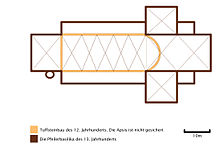Andreas Church (north)
The Andreaskirche is an old church in the East Frisian city of Norden . It was the first town church in the town and for a long time was in structural competition with the Ludgeri Church, which was founded by the local community and was in the immediate vicinity . This is due to the unusual history of the city of Norden, which was not founded centrally, but rather arose as a common center for the surrounding farmers, Ekel, Lintel and Westgaste. In the years that followed, they grew closer together and thus formed the core of the city.
history
The first town church was the Andreaskirche. It stood north of today's Ludgerikirche and had a predecessor made of wood, in the place of which a rectangular one-room church made of tuff was built in the 12th century as the first stone church building in the town. The building was about 37 meters long and probably had a semicircular apse. Later a square west tower was added to the church.
In the third quarter of the 13th century, the church was finally torn down and then rebuilt using the new material brick as a three-aisled pillar basilica with a vaulted transept and square choir. The initiative for this probably came from the Diocese of Bremen , to which the place belonged at the time. When it was completed in 1288, the building was 65 meters long and about 22 meters wide. Its 65 meter high west tower served seafarers as a navigation mark for several centuries. The two east towers on the choir flanks were added later and donated by two sisters from the Idzinga family of chiefs from the north. The choir flank towers, which are rare in East Frisia, were probably built based on the model of the church in Bunde .
The St. Andrew's Church probably served as a place of worship for the developing urban community. This is explained, among other things, by the fact that the church was consecrated to St. Andrew . He was the patron saint of the city and is still represented today as the holder of the North city coat of arms.
In 1531 an army of the chief Balthasar von Esens devastated the unfortified city. Among other things, the previous building of the Old Town Hall and several monasteries were destroyed and the St. Andrew's Church was badly damaged. Attempts to rebuild the St. Andrew's Church failed. The building remained a ruin, which gradually collapsed in the 17th and 18th centuries and served as a quarry for the northerners. The last remains were removed in 1756. Particularly valuable sculptures seem to have been brought to the Ludgerikirche, which subsequently took over the function of the town's main church. Today there are no more parts of the building rising from the Andreaskirche. The area on which it stood is taken up by the city's old cemetery. In 1996 the location of St. Andrew's Church was rediscovered through drilling investigations.
Today's St. Andrew's parish
The youngest parish in the city of Norden is the Evangelical-Lutheran Andreasgemeinde founded on the 1st of Advent 1996. With its name, it ties in with the history of the historic St. Andrew's Church, but focuses on the Lutherans living in the west of the city in its worship and pastoral activities. The number of its parishioners is around 3,600. She is looked after by two pastors. The Kükennüst kindergarten also belongs to the community .
literature
- Hermann Haiduck: The architecture of the medieval churches in the East Frisian coastal area . 2nd Edition. Ostfriesische Landschaftliche Verlags- und Vertriebs-GmbH, Aurich 2009, ISBN 978-3-940601-05-6 , p. 16, 100, 102, 118, 124, 191 .
Individual evidence
- ↑ Information according to the information board in the East Frisian Tea Museum in the north (with an attached local history museum).
- ^ Rolf Bärenfänger : Die Andreaskirche in Norden , in: Rolf Bärenfänger (editing and processing): Guide to archaeological monuments in Germany, Vol. 35 Ostfriesland, Stuttgart 1999, ISBN 3-8062-1415-8 , pp. 187f.
- ↑ Hajo van Lengen (ed.): The Frisian Freedom of the Middle Ages - Life and Legends , Verlag Ostfriesische Landschaft 2003, ISBN 3-932206-30-4 , p. 77.
- ^ Reinhard Ruge (text), Ev.-luth. Ludgerigemeinde Norden (ed.): The Ludgerikirche to the north . Norden 2000, p. 3.
- ↑ Information according to the information board in the East Frisian Tea Museum in the north (with an attached local history museum).
- ^ Johann Haddinga , Martin Stromann: Norden-Norddeich. An East Frisian coastal town introduces itself . Verlag SKN, Norden 2001, ISBN 3-928327-43-7 , p. 64.
- ↑ Homepage of the Andreaskirchengemeinde: Homepage ; accessed on November 2, 2011
- ↑ Homepage of the Evangelical Lutheran Church District North: Andreasgemeinde ; accessed on November 2, 2011
- ↑ Homepage of the Kindergarten Kükennüst ; accessed on November 2, 2011
Coordinates: 53 ° 35 ′ 46.1 ″ N , 7 ° 12 ′ 14.2 ″ E

